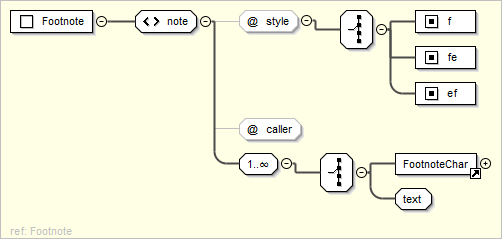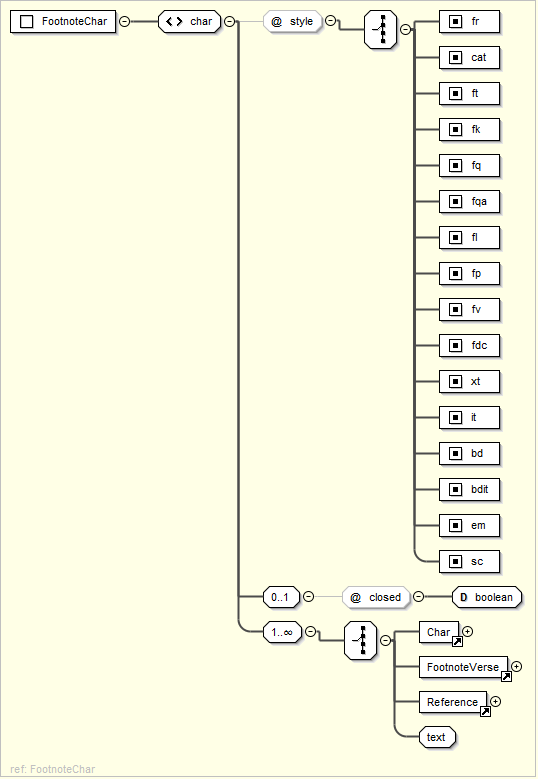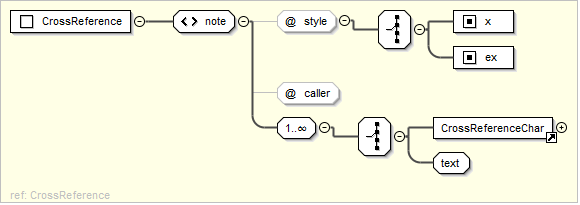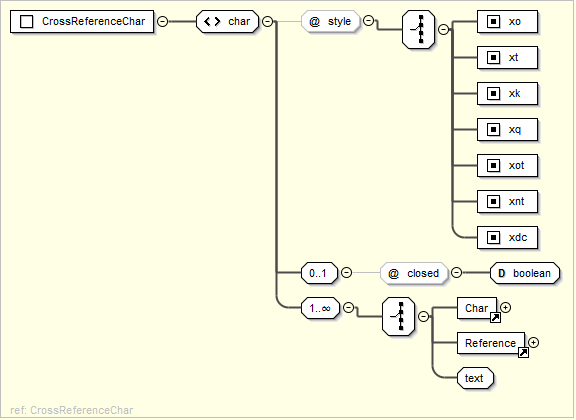<note> Types¶
<note> (Footnote)¶
- Element
note
empty (all content is contained within the note’s child char elements)- Added
1.0
- Use
Contains child <char> elements to contain the content for a footnote, endnote, or study note.
- @caller
Note caller. *
+|-| <user defined caller>
A <user defined caller> may be any single character or sequence of characters preferred as the caller for a note.- @style
Content (footnote) type. *
f(footnote) |fe(endnote) |ef(extended / study note)- Valid in
Book Titles, Book Introduction, Introduction End Titles, Chapter Text
- Parents
Diagram¶

<char> (Footnote)¶
![]() Schema pattern name: FootnoteChar
Schema pattern name: FootnoteChar
- Element
char
xsd:string- Added
1.0
- Use
An element for marking various footnote content types.
- @style
Footnote content type. *
The <char> (Footnote) @style types list (below) presents an itemization of @style values valid within <char> elements which are children of <note> @style=”f”, <note> @style=”fe”, and <note> @style=”ef”.- Valid in
Diagram¶

<char> (Footnote) @style Types¶
- @style
fr
- Use
Footnote “origin” reference.
This is the chapter and verse(s) that note refers to.- Valid In
<note caller="+" style="f">
<char style="fr">1.1: </char>
<char style="ft">Some manuscripts do not have </char>
<char style="fq">the Son of God.</char>
</note>
- @style
ft
- Use
Footnote text
The primary (explanatory) text of the footnote.- Valid In
- @style
fk
- Use
A specific keyword/term from the text for which the footnote is being provided.
- Valid In
-

<note caller="+" style="f">
<char style="fr">3.20: </char>
<char style="fk">Adam </char>
<char style="ft">This name in Hebrew means "all human beings."</char>
</note>
- @style
Footnote translation quotation.
- Use
A quotation from the current scripture text translation for which the note is being provided.
Longer quotations are sometimes shortened using an ellipsis (i.e. suspension dots “…”).- Valid In
-

<note caller="+" style="f">
<char style="fr">1.1: </char>
<char style="ft">Some manuscripts do not have </char>
<char style="fq">the Son of God.</char>
</note>
- @style
fqa
- Use
Footnote alternate translation.
Used to distinguish between a quotation of the current scripture text translation, and an alternate translation.- Valid In
-

<note caller="+" style="f">
<char style="fr">1.4: </char>
<char style="fq">John appeared in the desert, baptizing and preaching; </char>
<char style="ft">some manuscripts have </char>
<char style="fqa">John the Baptist appeared in the desert, preaching.</char>
</note>
- @style
fl
- Use
Footnote “label” text.
Can be used for marking or “labeling” a word or words which are used consistently across certain types of translation notes (such as the words “Or” in an alternative translation style note, “Others”, “Heb.”, “LXX” etc.).- Valid In
- @style
fp
- Use
Footnote additional paragraph.
Use this marker to if you need to indicate the start of a new paragraph within a footnote (uncommon).- Valid In
- @style
fv
- Use
Footnote verse number.
A verse number in the the text quotation or alternative translation.- Valid In
-

<note caller="+" style="f">
<char style="fr">7.38: </char>
<char style="ft">Jesus' words in verses 37-38 may be translated: </char>
<char style="fqa">“Whoever is thirsty should come to me and drink. </char>
<char style="fv">38</char> As the scripture says, ‘Streams of life-giving water
will pour out from within anyone who believes in me.’”
</note>
- @style
fdc
- Use
Material to be included only in publications that contain the Deuterocanonical/Apocrypha books.
- Valid In
Note
Other <char> @style types may be nested within any of the standard footnote <char> @style types shown in the list above.
<note> (CrossReference)¶
![]() Schema pattern name: CrossReference
Schema pattern name: CrossReference
- Element
note
empty (all content is contained within the note’s child char elements)- Added
1.0
- Use
Contains child <char> elements to contain the content for a cross reference or study cross reference.
- @caller
Cross reference caller. *
+|-| <user defined caller>
A <user defined caller> may be any single character or sequence of characters preferred as the caller for a note.- @style
Content (cross reference) type. *
x(cross reference) |ex(extended / study cross reference)- Valid in
Book Titles, Book Introduction, Introduction End Titles, Chapter Text
- Parents
Diagram¶

<char> (CrossReference)¶
![]() Schema pattern name: CrossReferenceChar
Schema pattern name: CrossReferenceChar
- Element
char
xsd:string- Added
1.0
- Use
An element for marking various cross reference content types.
- @style
Cross reference content type. *
The <char> (Cross Reference) @style types list (below) presents an itemization of @style values valid within <char> elements which are children of <note> @style=”x”.- Valid in
Diagram¶

<char> (Cross Reference) @style Types¶
- @style
xo
- Use
Cross reference origin reference.
This is the chapter and verse(s) that target (@style=”xt”) reference(s) are being provided for.- Valid In
-

<note caller="-" style="x">
<char style="xo">2.23: </char>
<char style="xt">Mk 1.24; Lk 2.39; Jn 1.45.</char>
</note>
- @style
xt
- Use
Cross reference target reference(s).
The list of target scripture passages being suggested as references for comparison/review with respect to the text (or concept) of the origin reference.
A list of book name abbreviations and chapter + verse references, separated by semicolons or other book list separator character.- Valid In
- @style
xk
- Use
A keyword from the scripture translation text which the target reference(s) also refer to.
- Valid In
- @style
xq
- Use
A quotation from the scripture text.
Use of a quotation would be intended to help the reader to understand the portion of text (or concept) for which the target (xt) reference(s) are being supplied.- Valid In
- @style
xot
- Use
References (or other text) which only to be included in publications that contain the Old Testament books.
- Valid In
- @style
xnt
- Use
References (or other text) which only to be included in publications that contain the New Testament books.
- Valid In
- @style
xdc
- Use
References (or other text) which only to be included in publications that contain the Deuterocanonical/Apocrypha books.
- Valid In
<note caller="-" style="x">
<char style="xo">1.26: </char>
<char style="xdc">Ws 2.23; Si 17.3,4;</char>
<char style="xt">1 Co 11.7.</char>
</note>